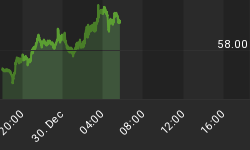It was a reasonably quiet Monday, as expected considering there was no economic data due. Stocks sagged in the morning, and both stocks and bonds rallied in the afternoon - the former to unchanged on the day, and the latter from unchanged to up a few basis points.
News was light, and I accidentally turned on CNBC.
It really must have been an accident, because the last thing I want is to let CNBC get into my head. Generally, it just outrages me to listen to the shilling that masquerades as "news" on this channel. I don't mean the guests; they are doing what I expect them to do. It's the talking heads who pretend to be analysts who bug me.
In any case, before I was able to operate the "mute" button I heard a brief discussion about the condition of the corporate borrowing market. The guest - I didn't catch his name - was earnestly making the case that "the financing is there" even if not everyone wants to borrow right now.
For some reason, economic bulls have had a hard time for the last couple of years in understanding how tight credit availability was in the immediate aftermath of the credit bust, and how long credit has stayed very tight. Now, corporate borrowing is finally loosening up some. In late 2008, even highly credit-worthy accounts had trouble renewing credit lines, for the simple reason that banks couldn't access financing markets either. In 2009, the markets continued to be tight although opening for top credits. In 2010, the borders were pushed further, and more companies were able to borrow. But credit availability is still tight.
The chart below shows the 52-week change in commercial bank credit (Source: Fed H.8) updated to the most-recent data. Bank credit is still contracting, slightly, on a 13-week rate of change as well. I would suggest, by the way, that one reason these numbers are no longer contracting as much is that foreclosures have stalled.

I've adjusted the series for the blip of MS and GS
joining "commercial banks" in 2008.
But we're really interested in credit availability to corporate borrowers. Is it true that "the financing is there," or is it the case that the decline in credit is a case of a lack of demand?
Bloomberg has two indices that are interesting. They detail total issuance of all dollar-denominated public and 144A corporate bonds sold in U.S. domestic and global markets. It stands to reason that if the financing is "there," and it doesn't seem to be "there" at the banks, then it may be available in the markets. Helpfully, Bloomberg has broken the data down into high-yield and investment-grade markets, and those two series are shown below for the life of the data.

Inv Grade: left axis. High yield: right axis
What may jump out at you is that investment grade issuance dropped in 2010, but high-yield issuance...well, exploded. The $287bln of high-yield issuance was 76% above the next-best year, which was 2009, and just about double the issuance from the 'lever up' heydays in 2006 and 2007.
So if you look at total issuance, it looks pretty flat (down just slightly in 2010), and with the bank credit numbers leveling off you'd say "we're back to normal." And, clearly, things are better than they were in 2008! But the changing composition of the market suggests something deeper is happening. I suspect that the bank loan books are improving in quality by extending credit to large, credit-worthy names (politically, I think it's hard in this environment to be showing off a contracting loan book) and cutting the weaker credits off. The big companies definitely see a healthy credit market for their names and their paper, and that's who we are hearing from when we hear "anyone who wants money can get it." Sure, General Electric can get it. Exxon-Mobil can get it. But what about those who don't rate a top-tier credit?
The weaker credits are being forced, if they are large enough, into the junk bond market, where they are fortunate in finding lots of investors lusting for yield. But I wonder what is happening to the smaller, less-than-stellar credits? And I wonder what will happen if the market goes "risk-off" again?
None of this has direct investment implications for today, but is part of the detective work of figuring out what is going on with this economy behind the scenes. Conditions are definitely better now than they were in 2009, and in parts of 2010. The jobs market is better. The credit market is better. But in both cases, we can honestly ask whether it is better for everybody or just the lucky few? And is that coloring some analysts' view of how good things really are?
I don't think that deleveraging is a bad thing, even though it means slower growth or even contraction for a while. What worries me right now is that no one is braced for deleveraging, like we were at the beginning of 2010. And yet, the surge in high-yield issuance tells me that not everything is humming along smoothly in the credit markets just yet. If the next "risk-off" period is a couple of years away, this will be a moot point. If it is a couple of weeks or months away, then it will not be. Be careful if you see a well-known junk name default, or if there are outflows from high-yield bond funds.
.
On Tuesday, Philly Fed President Plosser speaks in the morning, and Minnesota Fed President Kocherlakota speaks in the afternoon. Other than that, there is nothing on tap...except another NY-bound storm, scheduled to hit tomorrow night.
















